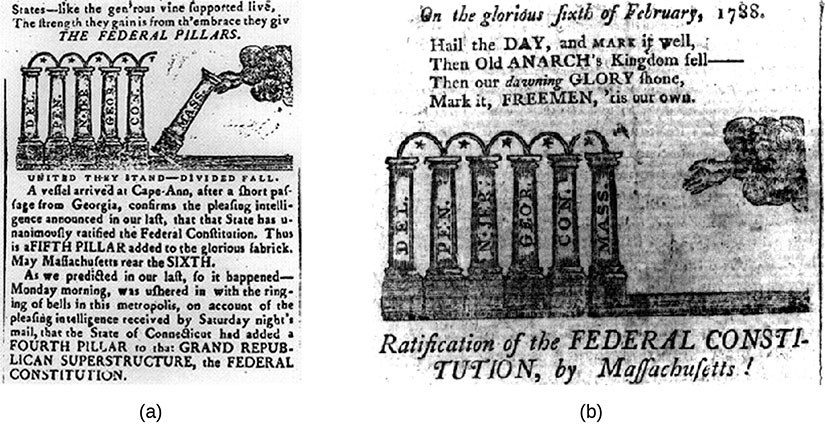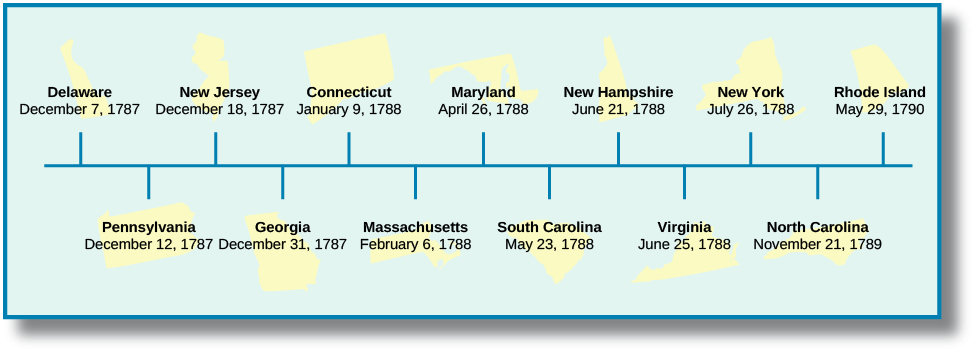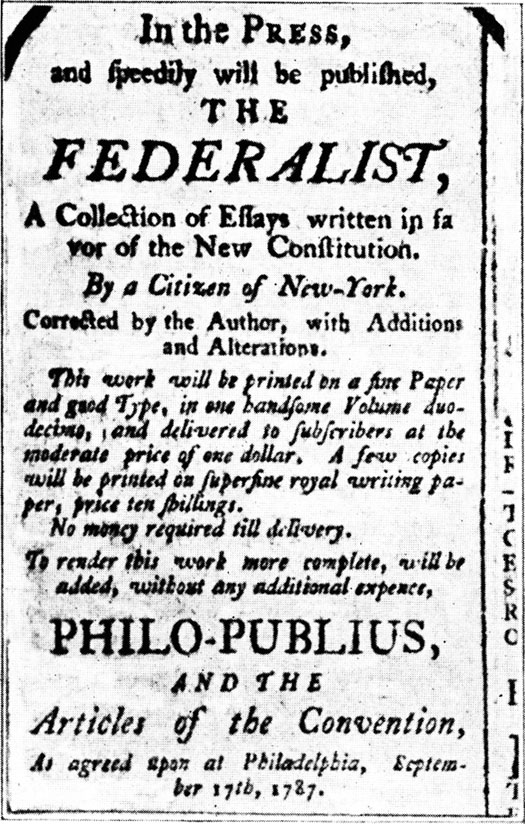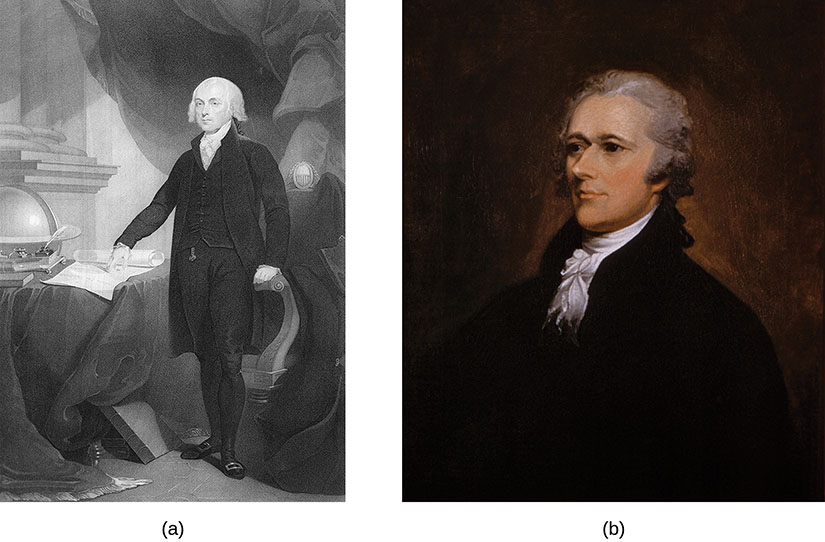Chapter 2: The Constitution and Its Origins
The Ratification of the Constitution
LEARNING OUTCOMES
By the end of this section, you will be able to:
- Identify the steps required to ratify the Constitution
- Describe arguments the framers raised in support of a strong national government and counterpoints raised by the Anti-Federalists
On September 17, 1787, the delegates to the Constitutional Convention in Philadelphia voted to approve the document they had drafted over the course of many months. Some did not support it, but the majority did. Before it could become the law of the land, however, the Constitution faced another hurdle. It had to be ratified by the states.
*Watch this video to learn more about the compromises made during the Constitutional Convention.
THE RATIFICATION PROCESS
Article VII, the final article of the Constitution, required that before the Constitution could become law and a new government could form, the document had to be ratified by nine of the thirteen states. Eleven days after the delegates at the Philadelphia convention approved it, copies of the Constitution were sent to each of the states, which were to hold ratifying conventions to either accept or reject it.
This approach to ratification was an unusual one. Since the authority inherent in the Articles of Confederation and the Confederation Congress had rested on the consent of the states, changes to the nation’s government should also have been ratified by the state legislatures. Instead, by calling upon state legislatures to hold ratification conventions to approve the Constitution, the framers avoided asking the legislators to approve a document that would require them to give up a degree of their own power. The men attending the ratification conventions would be delegates elected by their neighbors to represent their interests. They were not being asked to relinquish their power; in fact, they were being asked to place limits upon the power of their state legislators, whom they may not have elected in the first place. Finally, because the new nation was to be a republic in which power was held by the people through their elected representatives, it was considered appropriate to leave the ultimate acceptance or rejection of the Constitution to the nation’s citizens. If convention delegates, who were chosen by popular vote, approved it, then the new government could rightly claim that it ruled with the consent of the people.
The greatest sticking point when it came to ratification, as it had been at the Constitutional Convention itself, was the relative power of the state and federal governments. The framers of the Constitution believed that without the ability to maintain and command an army and navy, impose taxes, and force the states to comply with laws passed by Congress, the young nation would not survive for very long. But many people resisted increasing the powers of the national government at the expense of the states. Virginia’s Patrick Henry, for example, feared that the newly created office of president would place excessive power in the hands of one man. He also disapproved of the federal government’s new ability to tax its citizens. This right, Henry believed, should remain with the states.
Other delegates, such as Edmund Randolph of Virginia, disapproved of the Constitution because it created a new federal judicial system. Their fear was that the federal courts would be too far away from where those who were tried lived. State courts were located closer to the homes of both plaintiffs and defendants, and it was believed that judges and juries in state courts could better understand the actions of those who appeared before them. In response to these fears, the federal government created federal courts in each of the states as well as in Maine, which was then part of Massachusetts, and Kentucky, which was part of Virginia.[1]
Perhaps the greatest source of dissatisfaction with the Constitution was that it did not guarantee protection of individual liberties. State governments had given jury trials to residents charged with violating the law and allowed their residents to possess weapons for their protection. Some had practiced religious tolerance as well. The Constitution, however, did not contain reassurances that the federal government would do so. Although it provided for habeas corpus and prohibited both a religious test for holding office and granting noble titles, some citizens feared the loss of their traditional rights and the violation of their liberties. This led many of the Constitution’s opponents to call for a bill of rights and the refusal to ratify the document without one. The lack of a bill of rights was especially problematic in Virginia, as the Virginia Declaration of Rights was the most extensive rights-granting document among the states. The promise that a bill of rights would be drafted for the Constitution persuaded delegates in many states to support ratification.[2]
INSIDER PERSPECTIVE
Thomas Jefferson on the Bill of Rights
John Adams and Thomas Jefferson carried on a lively correspondence regarding the ratification of the Constitution. In the following excerpt (reproduced as written) from a letter dated March 15, 1789, after the Constitution had been ratified by nine states but before it had been approved by all thirteen, Jefferson reiterates his previously expressed concerns that a bill of rights to protect citizens’ freedoms was necessary and should be added to the Constitution:
“In the arguments in favor of a declaration of rights, . . . I am happy to find that on the whole you are a friend to this amendment. The Declaration of rights is like all other human blessings alloyed with some inconveniences, and not accomplishing fully it’s object. But the good in this instance vastly overweighs the evil. . . . This instrument [the Constitution] forms us into one state as to certain objects, and gives us a legislative & executive body for these objects. It should therefore guard us against their abuses of power. . . . Experience proves the inefficacy of a bill of rights. True. But tho it is not absolutely efficacious under all circumstances, it is of great potency always, and rarely inefficacious. . . . There is a remarkeable difference between the . . . Inconveniences which attend a Declaration of rights, & those which attend the want of it. . . . The inconveniences of the want of a Declaration are permanent, afflicting & irreparable: they are in constant progression from bad to worse.”[3]
What were some of the inconveniences of not having a bill of rights that Jefferson mentioned? Why did he decide in favor of having one?
It was clear how some states would vote. Smaller states, like Delaware, favored the Constitution. Equal representation in the Senate would give them a degree of equality with the larger states, and a strong national government with an army at its command would be better able to defend them than their state militias could. Larger states, however, had significant power to lose. They did not believe they needed the federal government to defend them and disliked the prospect of having to provide tax money to support the new government. Thus, from the very beginning, the supporters of the Constitution feared that New York, Massachusetts, Pennsylvania, and Virginia would refuse to ratify it. That would mean all nine of the remaining states would have to, and Rhode Island, the smallest state, was unlikely to do so. It had not even sent delegates to the convention in Philadelphia. And even if it joined the other states in ratifying the document and the requisite nine votes were cast, the new nation would not be secure without its largest, wealthiest, and most populous states as members of the union.
THE RATIFICATION CAMPAIGN
On the question of ratification, citizens quickly separated into two groups: Federalists and Anti-Federalists. The Federalists supported it. They tended to be among the elite members of society—wealthy and well-educated landowners, businessmen, and former military commanders who believed a strong government would be better for both national defense and economic growth. A national currency, which the federal government had the power to create, would ease business transactions. The ability of the federal government to regulate trade and place tariffs on imports would protect merchants from foreign competition. Furthermore, the power to collect taxes would allow the national government to fund internal improvements like roads, which would also help businessmen. Support for the Federalists was especially strong in New England.
Opponents of ratification were called Anti-Federalists. Anti-Federalists feared the power of the national government and believed state legislatures, with which they had more contact, could better protect their freedoms. Although some Anti-Federalists, like Patrick Henry, were wealthy, most distrusted the elite and believed a strong federal government would favor the rich over those of “the middling sort.” This was certainly the fear of Melancton Smith, a New York merchant and landowner, who believed that power should rest in the hands of small, landowning farmers of average wealth who “are more temperate, of better morals and less ambitious than the great.”[4] Even members of the social elite, like Henry, feared that the centralization of power would lead to the creation of a political aristocracy, to the detriment of state sovereignty and individual liberty.
Related to these concerns were fears that the strong central government Federalists advocated for would levy taxes on farmers and planters, who lacked the hard currency needed to pay them. Many also believed Congress would impose tariffs on foreign imports that would make American agricultural products less welcome in Europe and in European colonies in the western hemisphere. For these reasons, Anti-Federalist sentiment was especially strong in the South.
Some Anti-Federalists also believed that the large federal republic that the Constitution would create could not work as intended. Americans had long believed that virtue was necessary in a nation where people governed themselves (i.e., the ability to put self-interest and petty concerns aside for the good of the larger community). In small republics, similarities among members of the community would naturally lead them to the same positions and make it easier for those in power to understand the needs of their neighbors. In a larger republic, one that encompassed nearly the entire Eastern Seaboard and ran west to the Appalachian Mountains, people would lack such a strong commonality of interests.[5]
Likewise, Anti-Federalists argued, the diversity of religion tolerated by the Constitution would prevent the formation of a political community with shared values and interests. The Constitution contained no provisions for government support of churches or of religious education, and Article VI explicitly forbade the use of religious tests to determine eligibility for public office. This caused many, like Henry Abbot of North Carolina, to fear that government would be placed in the hands of “pagans . . . and Mahometans [Muslims].”[6]
It is difficult to determine how many people were Federalists and how many were Anti-Federalists in 1787. The Federalists won the day, but they may not have been in the majority. First, the Federalist position tended to win support among businessmen, large farmers, and, in the South, plantation owners. These people tended to live along the Eastern Seaboard. In 1787, most of the states were divided into voting districts in a manner that gave more votes to the eastern part of the state than to the western part.[7] Thus, in some states, like Virginia and South Carolina, small farmers who may have favored the Anti-Federalist position were unable to elect as many delegates to state ratification conventions as those who lived in the east. Small settlements may also have lacked the funds to send delegates to the convention.[8]
In all the states, educated men authored pamphlets and published essays and cartoons arguing either for or against ratification (Figure 2.11). Although many writers supported each position, it is the Federalist essays that are now best known. The arguments these authors put forth, along with explicit guarantees that amendments would be added to protect individual liberties, helped to sway delegates to ratification conventions in many states.

For obvious reasons, smaller, less populous states favored the Constitution and the protection of a strong federal government. As shown in Figure 2.12, Delaware and New Jersey ratified the document within a few months after it was sent to them for approval in 1787. Connecticut ratified it early in 1788. Some of the larger states, such as Pennsylvania and Massachusetts, also voted in favor of the new government. New Hampshire became the ninth state to ratify the Constitution in the summer of 1788.

Although the Constitution went into effect following ratification by New Hampshire, four states still remained outside the newly formed union. Two were the wealthy, populous states of Virginia and New York. In Virginia, James Madison’s active support and the intercession of George Washington, who wrote letters to the convention, changed the minds of many. Some who had initially opposed the Constitution, such as Edmund Randolph, were persuaded that the creation of a strong union was necessary for the country’s survival and changed their position. Other Virginia delegates were swayed by the promise that a bill of rights similar to the Virginia Declaration of Rights would be added after the Constitution was ratified. On June 25, 1788, Virginia became the tenth state to grant its approval.
The approval of New York was the last major hurdle. Facing considerable opposition to the Constitution in that state, Alexander Hamilton, James Madison, and John Jay wrote a series of essays, beginning in 1787, arguing for a strong federal government and support of the Constitution (Figure 2.13). Later compiled as The Federalist and now known as The Federalist Papers, these eighty-five essays were originally published in newspapers in New York and other states under the name of Publius, a supporter of the Roman Republic.

The essays addressed a variety of issues that troubled citizens. For example, in Federalist No. 51, attributed to James Madison (Figure 2.14), the author assured readers they did not need to fear that the national government would grow too powerful. The federal system, in which power was divided between the national and state governments, and the division of authority within the federal government into separate branches would prevent any one part of the government from becoming too strong. Furthermore, tyranny could not arise in a government in which “the legislature necessarily predominates.” Finally, the desire of office holders in each branch of government to exercise the powers given to them, described as “personal motives,” would encourage them to limit any attempt by the other branches to overstep their authority. According to Madison, “Ambition must be made to counteract ambition.”
Other essays countered different criticisms made of the Constitution and echoed the argument in favor of a strong national government. In Federalist No. 35, for example, Hamilton (Figure 2.14) argued that people’s interests could in fact be represented by men who were not their neighbors. Indeed, Hamilton asked rhetorically, would American citizens best be served by a representative “whose observation does not travel beyond the circle of his neighbors and his acquaintances” or by someone with more extensive knowledge of the world? To those who argued that a merchant and land-owning elite would come to dominate Congress, Hamilton countered that the majority of men currently sitting in New York’s state senate and assembly were landowners of moderate wealth and that artisans usually chose merchants, “their natural patron[s] and friend[s],” to represent them. An aristocracy would not arise, and if it did, its members would have been chosen by lesser men. Similarly, Jay reminded New Yorkers in Federalist No. 2 that union had been the goal of Americans since the time of the Revolution. A desire for union was natural among people of such “similar sentiments” who “were united to each other by the strongest ties,” and the government proposed by the Constitution was the best means of achieving that union.

Objections that an elite group of wealthy and educated bankers, businessmen, and large landowners would come to dominate the nation’s politics were also addressed by Madison in Federalist No. 10. Americans need not fear the power of factions or special interests, he argued, for the republic was too big and the interests of its people too diverse to allow the development of large, powerful political parties. Likewise, elected representatives, who were expected to “possess the most attractive merit,” would protect the government from being controlled by “an unjust and interested [biased in favor of their own interests] majority.”
For those who worried that the president might indeed grow too ambitious or king-like, Hamilton, in Federalist No. 68, provided assurance that placing the leadership of the country in the hands of one person was not dangerous. Electors from each state would select the president. Because these men would be members of a “transient” body called together only for the purpose of choosing the president and would meet in separate deliberations in each state, they would be free of corruption and beyond the influence of the “heats and ferments” of the voters. Indeed, Hamilton argued in Federalist No. 70, instead of being afraid that the president would become a tyrant, Americans should realize that it was easier to control one person than it was to control many. Furthermore, one person could also act with an “energy” that Congress did not possess. Making decisions alone, the president could decide what actions should be taken faster than could Congress, whose deliberations, because of its size, were necessarily slow. At times, the “decision, activity, secrecy, and dispatch” of the chief executive might be necessary.
LINK TO LEARNING
The Library of Congress has The Federalist Papers on their website. The Anti-Federalists also produced a body of writings, less extensive than The Federalists Papers, which argued against the ratification of the Constitution. However, these were not written by one small group of men as The Federalist Papers had been. A collection of the writings that are unofficially called The Anti-Federalist Papers is also available online.
The arguments of the Federalists were persuasive, but whether they actually succeeded in changing the minds of New Yorkers is unclear. Once Virginia ratified the Constitution on June 25, 1788, New York realized that it had little choice but to do so as well. If it did not ratify the Constitution, it would be the last large state that had not joined the union. Thus, on July 26, 1788, the majority of delegates to New York’s ratification convention voted to accept the Constitution. A year later, North Carolina became the twelfth state to approve. Alone and realizing it could not hope to survive on its own, Rhode Island became the last state to ratify, nearly two years after New York had done so.
FINDING A MIDDLE GROUND
Term Limits
One of the objections raised to the Constitution’s new government was that it did not set term limits for members of Congress or the president. Those who opposed a strong central government argued that this failure could allow a handful of powerful men to gain control of the nation and rule it for as long as they wished. Although the framers did not anticipate the idea of career politicians, those who supported the Constitution argued that reelecting the president and reappointing senators by state legislatures would create a body of experienced men who could better guide the country through crises. A president who did not prove to be a good leader would be voted out of office instead of being reelected. In fact, presidents long followed George Washington’s example and limited themselves to two terms. Only in 1951, after Franklin Roosevelt had been elected four times, was the Twenty-Second Amendment passed to restrict the presidency to two terms.
Are term limits a good idea? Should they have originally been included in the Constitution? Why or why not? Are there times when term limits might not be good?
CHAPTER REVIEW
See the Chapter 2.4 Review for a summary of this section, the key vocabulary, and some review questions to check your knowledge.
- Pauline Maier. 2010. Ratification: The People Debate the Constitution, 1787-1788. New York: Simon & Schuster, 464. ↵
- Maier, Ratification, 431. ↵
- Letter from Thomas Jefferson to James Madison, March 15, 1789, https://www.gwu.edu/~ffcp/exhibit/p7/p7_1text.html. ↵
- Isaac Krannick. 1999. “The Great National Discussion: The Discourse of Politics in 1787.” In What Did the Constitution Mean to Early Americans? ed. Edward Countryman. Boston: Bedford/St. Martins, 52. ↵
- Krannick, Great National Discussion, 42-43. ↵
- Krannick, Great National Discussion, 42. ↵
- Evelyn C. Fink and William H. Riker. 1989. “The Strategy of Ratification.” In The Federalist Papers and the New Institutionalism, eds. Bernard Grofman and Donald Wittman. New York: Agathon, 229. ↵
- Fink and Riker, Strategy of Ratification, 221. ↵
those who supported ratification of the Constitution
those who did not support ratification of the Constitution
a collection of eighty-five essays written by Alexander Hamilton, James Madison, and John Jay in support of ratification of the Constitution

